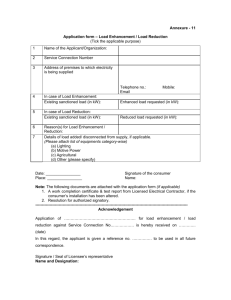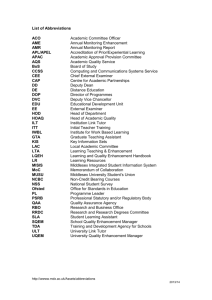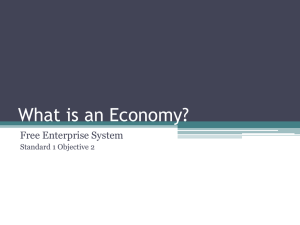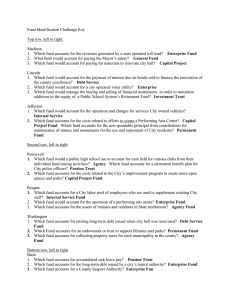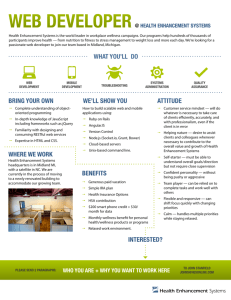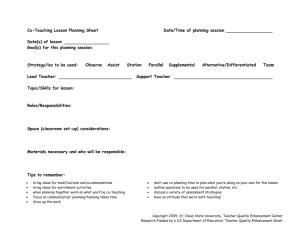39 Closing Thoughts on Value Enhancement
advertisement
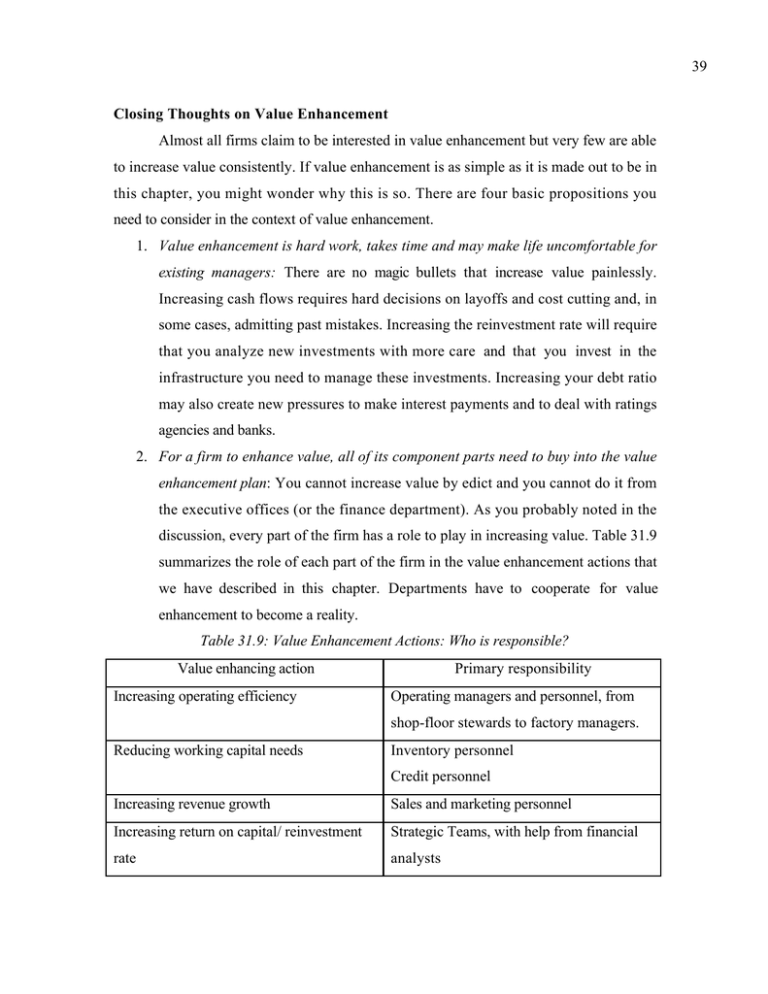
39 Closing Thoughts on Value Enhancement Almost all firms claim to be interested in value enhancement but very few are able to increase value consistently. If value enhancement is as simple as it is made out to be in this chapter, you might wonder why this is so. There are four basic propositions you need to consider in the context of value enhancement. 1. Value enhancement is hard work, takes time and may make life uncomfortable for existing managers: There are no magic bullets that increase value painlessly. Increasing cash flows requires hard decisions on layoffs and cost cutting and, in some cases, admitting past mistakes. Increasing the reinvestment rate will require that you analyze new investments with more care and that you invest in the infrastructure you need to manage these investments. Increasing your debt ratio may also create new pressures to make interest payments and to deal with ratings agencies and banks. 2. For a firm to enhance value, all of its component parts need to buy into the value enhancement plan: You cannot increase value by edict and you cannot do it from the executive offices (or the finance department). As you probably noted in the discussion, every part of the firm has a role to play in increasing value. Table 31.9 summarizes the role of each part of the firm in the value enhancement actions that we have described in this chapter. Departments have to cooperate for value enhancement to become a reality. Table 31.9: Value Enhancement Actions: Who is responsible? Value enhancing action Increasing operating efficiency Primary responsibility Operating managers and personnel, from shop-floor stewards to factory managers. Reducing working capital needs Inventory personnel Credit personnel Increasing revenue growth Sales and marketing personnel Increasing return on capital/ reinvestment Strategic Teams, with help from financial rate analysts 40 Build brand name Advertising personnel Other competitive advantages Strategic analysts Reduce cost of financing Finance department 3. Value enhancement has to be firm-specific: No two firms in trouble share the same problems and using a cook-book approach seldom works in value enhancement. You have to begin by diagnosing the specific problems faced by the firm you are analyzing and tailor a response to these problems. Thus, the value enhancement plan you would devise for a mature firm with cost overruns will be very different from the plan you would devise for a young firm that has a product that no longer meets market needs. 4. Price enhancement may not always follow value enhancement: This is perhaps the most disappointing aspect of value enhancement. A firm that takes all the right actions may not necessarily be rewarded immediately by financial markets. In some cases, markets may even punish such firms because of the effects of these actions on reported earnings. We remain convinced that in the long terms, markets will recognize value enhancing actions and reward them, but the manager who took these actions may not be around to share in the rewards. Summary Value enhancement is clearly on the minds of many managers today. Building on the discounted cash flow principles developed in the last chapter, the value of a firm can be increased by changing one of the four primary inputs into valuation: the cash flows from assets in place, the expected growth rate during the high growth period, the length of the high growth period and the cost of capital. Conversely, actions that do not change any of these variables cannot create value. Cash flows from assets in place can be increased by cost cutting and more efficient operations, as well as by lowering taxes paid on income and reducing investment needs (capital maintenance and non-cash working capital investments). Expected growth can be increased by increasing the reinvestment rate or the return on capital, but increases in the reinvestment rate will generate value only if the return on capital exceeds the cost of capital. High growth, at least the value creating kind, 41 can be made to last longer by generating new competitive advantages or augments existing ones. Finally, the cost of capital can be lowered by moving towards an optimal debt ratio, using debt that is more suited for the assets being financed and by reducing market risk. 42 Problems 1. Marion Manufacturing, a steel company, announces that it will be taking a major restructuring charge that will lower earnings this year by $500 million. Assume that the charge is not tax deductible and has no effects on operations. a. What will the effect of this charge be on the value of the firm? a. When the firm announces the charge, what effect would you expect it to have on the stock price? Is your answer consistent with your response to (a)? 2. Universal Health Care (UHC) is a company whose stock price has declined by 40% in the last year. In the current year, UHC earned $300 million in pre-tax operating income on revenues of $10 billion. The new CEO of the firm has proposed cost-cutting measures she anticipates will save the firm $100 million in expenses, without any effect on revenues. Assume the firm is growing at a stable rate of 5% a year and its cost of capital is 10%; neither number is expected to change as a consequence of the cost cutting. The firm’s tax rate is 40%. (You can assume that the firm reinvests $100 million each year and that this reinvestment will not change as the firm cuts costs.) • What effect will the cost cutting have on value? • What effect will the cost cutting have on value, if the expected growth rate will drop to 4.5% as a consequence? (Some of the costs cut were designed to generate future growth) 3. Atlantic Cruise Lines operates cruise ships and is headquartered in Florida. The firm had $100 million in pre-tax operating income in the current year, of which it reinvested $25 million. The firm expects its operating income to grow 4% in perpetuity and maintain its existing reinvestment rate. Atlantic has a capital structure composed 60% of equity and 40% of debt. Its cost of equity is 12% and it has a pretax cost of borrowing of 8%. The firm currently faces a tax rate of 40%. a. Estimate the value of the firm. b. Assume now that Atlantic Cruise Lines will move its headquarters to the Cayman Islands. If its tax rate drops to 0% as a consequence, estimate the effect on value of the shift. 43 4. Furniture Depot is a retail chain selling furniture and appliances. The firm has after-tax operating income of $250 million in the current year on revenues of $5 billion. The firm also has non-cash working capital of $1 billion. The net capital expenditures this year is $100 million and expects revenues, operating income and net capital expenditures to grow 5% a year forever. The firm’s cost of capital is 9%. a. Assume that non-cash working capital remains at the existing percent of revenues, estimate the value of the firm. b. Assume now that the firm is able to reduce its non-cash working capital requirement by 50%. Estimate the effect on value of this change. c. If as a consequence of this non-cash working capital change, earnings growth declines to 4.75%, what would the effect on value be of the drop in non-cash working capital? 5. General Systems is a firm that manufactures personal computers. As a top manager in the firm, you are considering changes in the way the firm is run. Currently, the firm has after-tax operating income of $50 million on capital invested of $250 million (at the beginning of the year). The firm also reinvests $25 million in net capital expenditures and working capital. a. Estimate the expected growth rate in earnings, given the firm’s current return on capital and reinvestment rate. b. Holding the return on capital constant, what would happen to the expected growth rate if the firm increased its reinvestment rate to 80%? c. What would the effect on growth be, if as the reinvestment rate increases to 80%, the return on capital on investments drops by 5%? (For instance, if the return on capital is currently 18%, it will drop to 13%.) 6. Compaq Computers has seen its stock price decline from $45 to $24. The firm is expected to reinvest 50% of its expected after-tax operating income of $2 billion in new investments and to earn a return on capital of 10.69%. The firm is all equity financed and has a cost of equity of 11.5%. a. What is the firm’s expected growth rate, assuming that it maintains its existing reinvestment rate and return on capital? 44 b. Assuming that this growth is perpetual, what is the value of the firm? c. How much value is being created or destroyed by the firm’s new investments? 7. (Refer to problem 6) Now assume that Compaq’s optimal debt ratio is 20%. Its cost of equity will increase to 12.5% and its after-tax cost of debt will be 4.5% at the optimal debt ratio. a. What is the firm’s expected growth rate, assuming it maintains its existing reinvestment rate and return on capital? b. Assuming this growth is perpetual, what is the value of the firm? c. How much value is being created or destroyed by the firm’s new investments? 8. Coca Cola is considered to have one of the most valuable brand names in the world. The firm has an after-tax operating margin of 20% on revenues of $25 billion. The capital invested in the firm is $10 billion. In addition, Coca Cola reinvests 50% of its after-tax operating earnings. a. Estimate the expected growth in operating earnings, assuming Coca Cola can sustain these values for the foreseeable future. b. Assume generic soft drink manufacturers have after-tax operating margins of only 7.5%. If Coca Cola maintains its existing reinvestment rate but loses its brand name value, estimate the expected growth rate in operating earning. (You can assume that, with the loss in brand name value, Coca Cola’s operating margins would drop to 7.5%, as well.) 9. BioMask Genetics is a biotechnology firm with only one patent to its name. The aftertax operating earnings in the current year is $100 million and the firm has no reinvestment needs. The patent will expire in 3 years and the firm will have a 15% growth rate in earnings during that period. After year 3, operating earnings are expected to remain constant forever. The firm’s management is considering an advertising plan designed to build up the brand name of its patented product. The advertising campaign will cost $50 million (pre-tax) a year over the next 3 years; the firm’s tax rate is 40%. The firm believes this campaign will allow it to maintain a 15% growth rate for 10 years, as the brand name 45 compensates for the loss of the patent protection. After year 10, the operating earnings are expected to remain constant forever. The firm has a cost of capital of 10%. a. Estimate the value of the firm, assuming it does not embark on the advertising campaign. b. Estimate the value of the firm, with the advertising campaign. c. Assume there is no guarantee the growth rate will last 10 years as a result of the campaign. What would the probability of success need to be for the campaign to be financially viable? 10. Sunmask is a cosmetics firm that has seen its stock price fall and its earnings decline in the last year. You have been hired as the new CEO of the company and a careful analysis of Sunmask’s current financials reveals the following. - The firm currently has after-tax operating earnings of $300 million on revenues of $10 billion and a capital turnover ratio (sales/book value of capital) of 2.5. - The firm is expected to reinvest 60% of its after-tax operating income. - The firm is all equity financed and has a cost of capital of 10%. a. Estimate the value of the firm, assuming existing policies continue forever. (Returns on capital and reinvestment rates remain constant forever, as well.) b. Assume that you can increase operating margins from 3% to 5% without affecting the capital turnover ratio, that you can lower the reinvestment rate to 40%, and that the cost of capital will become 9%, if you shift to your optimal debt ratio. How much would your firm value increase if you were able to make these changes?
